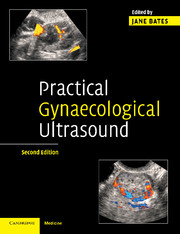Book contents
- Frontmatter
- Contents
- List of contributors
- Preface
- 1 Equipment selection and instrumentation
- 2 Practical equipment operation and technique
- 3 Anatomy, physiology and ultrasound appearances
- 4 Pathology of the uterus, cervix and vagina
- 5 Pathology of the ovaries, fallopian tubes and adnexae
- 6 Ultrasound in the acute pelvis
- 7 Ultrasound and fertility
- 8 Paediatric gynaecological ultrasound
- 9 Clinical management of patients: the gynaecologist's perspective
- Index
- References
1 - Equipment selection and instrumentation
Published online by Cambridge University Press: 04 March 2010
- Frontmatter
- Contents
- List of contributors
- Preface
- 1 Equipment selection and instrumentation
- 2 Practical equipment operation and technique
- 3 Anatomy, physiology and ultrasound appearances
- 4 Pathology of the uterus, cervix and vagina
- 5 Pathology of the ovaries, fallopian tubes and adnexae
- 6 Ultrasound in the acute pelvis
- 7 Ultrasound and fertility
- 8 Paediatric gynaecological ultrasound
- 9 Clinical management of patients: the gynaecologist's perspective
- Index
- References
Summary
Equipment selection
Introduction
The selection of equipment for gynaecological ultrasound, as in other clinical areas, amounts to:
selecting the scanner
selecting the transducer
selecting how best to use them
Although the operator may have little or no choice about the scanner to be used, it is important to recognise that it is the combination of all three of the above which is critical. A proficient operator getting the best out of poor equipment is frequently more effective than a poor operator using potentially good equipment in an uninformed, unthinking or poorly thought-out manner. It follows that whoever is using the equipment needs a good understanding of the ultrasonic imaging process, its limitations and characteristics. In particular, there is a need to understand the many compromises that exist, how they come about and how the operator can control the choices being made in order to optimise the quality of the scan. The list below summarises the main considerations to be taken into account before the scan begins:
spatial resolution
temporal resolution
penetration
contrast resolution
probe shape and size
scanning ergonomics
operating modes (e.g. pulsed and colour Doppler)
contrast agents
safety (acoustic, mechanical, electrical, biological, chemical)
Note that the transducer frequency is omitted from the above list. This is partly because manufacturer's probe labelling may be inaccurate but, more importantly, because the probe frequency is not a good predictor of image quality and certainly does not describe it. The operator may well find that a low-frequency probe on one scanner gives a better image than a higher-frequency probe on another.
- Type
- Chapter
- Information
- Practical Gynaecological Ultrasound , pp. 1 - 14Publisher: Cambridge University PressPrint publication year: 2006



